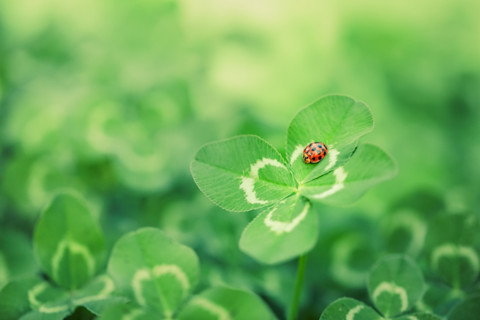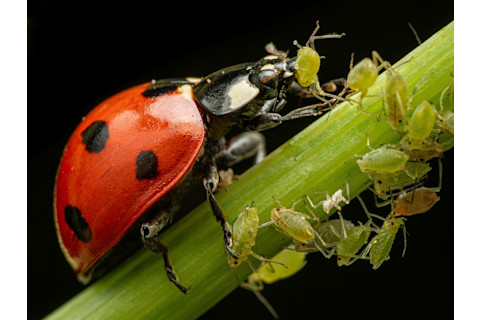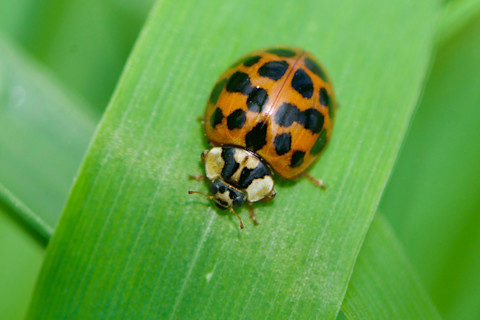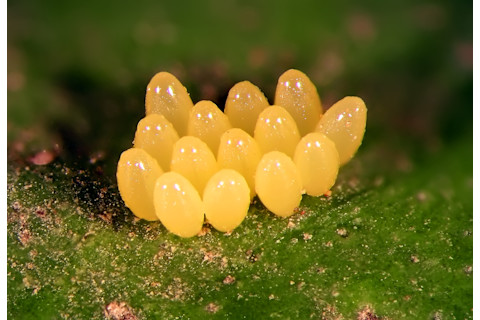Of the thousands of insect species crawling and flying around the world, ladybugs probably rank among some of the cutest. These tiny, rotund creatures scuttle about on plant leaves, easily distinguishable thanks to their sports car red and small black spots. Sometimes, they might even land on you – if you’re lucky.
There are some 5,000 species of ladybugs on Earth, though the most common type in North America is the convergent ladybug. Contrary to the name, they’re not actually “bugs” but rather beetles. In other regions, they go by other nicknames as well, including “ladybirds.”
There’s much to learn about ladybugs: They’re avid aphid eaters, and this diet of pests makes most species in the Coccinellidae family, where ladybugs hail from, farmers’ best friends. They gather in large groups to hibernate through the winter, finding their homes in logs, ground cover, and sometimes even houses. While they’re known for their vibrant reds, ladybugs can come in all sorts of colors – yellow, orange, and even solid black.
Here are some other facts about the ladybug.
What Do Ladybugs Symbolize?

(Credit: Leigh Prather/Shutterstock)
Leigh Prather/Shutterstock
Ladybugs have many myths and religious connotations. In Catholicism, for example, they are associated with the Virgin Mary. According to the University of Dayton, Ohio, it’s also possible that ladybugs had ties with other religious figures before Christianity — with the faith later assimilating the beetle as a symbol for its own purposes.
The more common myth that we associate with ladybugs is its connection with good luck. You might’ve heard the superstition that killing a ladybug brings you bad luck, while your fortunes are looking great if one lands on you.
It’s possible that this idea sprang from the fact that, in reality, ladybugs do act as forms of natural pest control in agriculture. Having a ladybug around means farmers and gardeners won’t see many more pesky aphids on their crops. For this reason, ladybugs are even referred to as biological control agents, due to their habits of preying upon aphids and other crop pests.
Read More: Do Insects Have Feelings and Consciousness?
Do Ladybugs Bite?

(Credit: Abdus Salam098/Shutterstock)
Abdus Salam098/Shutterstock
While ladybugs are certainly harmless to humans – they can’t poison, sting, or suck up your blood for a meal – they can bite people in rare cases. These bites hardly get powerful enough actually to puncture the skin. More often, ladybugs become problems for people due to their habits of overwintering inside of homes.
As a defense mechanism, ladybugs will also do what’s called “reflex bleeding,” in which they secrete a noxious liquid from their joints in order to ward off predators. This liquid emits a foul odor, which is why it’s wise to avoid crushing ladybugs.
Read More: 20 Things You Didn't Know About ... Bug Bites
What Do Ladybugs Eat?

(Credit: Szabadi Jeno Tibor/Shutterstock)
Szabadi Jeno Tibor/Shutterstock
Ladybugs go for aphids as their primary prey. Female ladybugs even lay their eggs on leaves ripe with aphid colonies so that when larvae hatch, they already have a ready supply of food to feast on. A single convergent ladybug larva might consume several hundred aphids in the two weeks that it takes to grow fully.
Alternative prey include whiteflies, beetle and moth larvae, and even fungi and other types of plant matter. This doesn’t necessarily mean that ladybugs are generalists that can thrive in any ecosystem, though. Scientists found in a 2020 study in BMC Genomics that, after testing how ladybugs functioned when consuming aphids versus alternative prey, ladybugs didn’t fare as well when exclusively eating non-aphids.
Read More: 5 Of The World's Largest Insects
Why Do Ladybugs Have Spots?

(Credit: Gerrit Lammers/Shutterstock)
Gerrit Lammers/Shutterstock
While ladybugs can act as natural pest control, they themselves can become prey to other creatures, like birds or wasps.
As a survival mechanism, their brightly colored and spotted shells serve to warn other predators to stay away lest they want to get a mouthful of something foul. This evolutionary survival mechanism is known as aposematism. Ladybugs can live up to one year, according to the San Diego Zoo, though they finish fully developing after about 3-7 weeks.
Read More: How Do Animals Evolve to Be So Colorful?
How to Get Rid of Ladybugs

(Credit: Protasov AN/Shutterstock)
Protasov AN/Shutterstock
While you might cherish seeing a stray ladybug or two around, sometimes they can gather in such large quantities inside homes that they become a nuisance.
Even if you don’t see many ladybugs crowding around your home, there are ways to tell that you have an infestation on your hands. Ladybug droppings look like black, tiny pellets, and those can be scattered around the house if they’ve invaded. Or, you might find small, citrus-colored masses of ladybug eggs on plant stems or leaves around the house. You might even smell the foul odors that ladybugs can secrete when disturbed.
Certain spots around the house are more prone to infestations, such as dark, warm places like attics, basements, or cracks and crevices. To prevent infestations, professionals advise sealing up any cavities in the house, cleaning up any food and water spills, and avoiding the use of chemical pesticides.
Instead, environment-friendly alternatives like citrus, mint, and bay leaves can naturally repel these beetles away from your property. Other natural insect repellants might include spraying mixtures of equal parts vinegar and water or diluted peppermint oil. Vacuuming ladybugs up is also a much better alternative to crushing them.
Read More: Why Are We Afraid of Bugs?
How to Attract Ladybugs

(Credit: Delbars/Shutterstock)
Delbars/Shutterstock
It might seem appealing to purchase ladybugs and release them into your gardens to protect your plants. However, some scientists warn against this approach, given that ladybugs are often mistreated in the collection and purchase process. Moreover, releasing additional organisms into areas where there might already be a ladybug population could further unbalance the current ecosystem.
Rather, cultivating pollinator-friendly plants works as a natural method of attracting ladybugs to your place. Among ladybugs’ top haunts are chives, dills, dandelions, or marigolds. Even having decoy plants that aphids like to munch on can lure pests away from your crops – and you might find more ladybugs that way, all on your own.
Article Sources
Our writers at Discovermagazine.com use peer-reviewed studies and high-quality sources for our articles, and our editors review for scientific accuracy and editorial standards. Review the sources used below for this article:
Pajarito Environmental Education Center. The Life Cycle of the Ladybug
University of Dayton. Ladybugs and Mary
BIO Web of Conferences. What makes lady beetles effective natural enemies in preventative biological control?
Arthropod Structure & Development. Structural adaptations and mechanism of reflex bleeding in the larvae of the myrmecophilous ladybird Diomus thoracicus
Britannica. Ladybug
BMC Genomics. Changes in life history traits and transcriptional regulation of Coccinellini ladybirds in using alternative prey
Arthropods. Conspicuousness and toxicity of Coccinellidae: An aposematic review
San Diego Zoo. Ladybug
Penn State University. Multicolored Asian Lady Beetle (Ladybug)
Purdue University. Asian Lady Beetle
Rochester Institute of Technology. Exploring the complexities of using ladybugs as pest control
Homes and Gardens. How to attract ladybugs to your yard – this natural aphid predator is more beneficial than you realize















